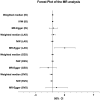Circulating N-Terminal Probrain Natriuretic Peptide Levels in Relation to Ischemic Stroke and Its Subtypes: A Mendelian Randomization Study
- PMID: 35273636
- PMCID: PMC8902306
- DOI: 10.3389/fgene.2022.795479
Circulating N-Terminal Probrain Natriuretic Peptide Levels in Relation to Ischemic Stroke and Its Subtypes: A Mendelian Randomization Study
Abstract
Mendelian randomization was used to evaluate the potential causal association between N-terminal probrain natriuretic peptide (NT-proBNP) and ischemic stroke based on summary statistics data from large-scale genome-wide association studies. Three single-nucleotide polymorphisms (SNPs) rs198389, rs13107325, and rs11105306 associated with NT-proBNP levels found in large general populations and in patients with acute heart disease were used as instrumental variables. The results of genetic association analysis of each single SNP show that there is no significant association between NT-proBNP levels and ischemic stroke or its subtypes, whereas rs198389 alone has a suggestive association with large-artery atherosclerosis stroke. The MR analysis of three SNPs shows that NT-proBNP levels may reduce the risk of small-vessel occlusion stroke suggestively. This genetic analysis provides insights into the pathophysiology and treatment of ischemic stroke.
Keywords: N-terminal pro-brain natriuretic peptide; mendelian randomization; risk predictor; single nucleotide polymorphisms; stroke.
Copyright © 2022 Li, Xu, Wu, Wu, Li and Ji.
Conflict of interest statement
The authors declare that the research was conducted in the absence of any commercial or financial relationships that could be construed as a potential conflict of interest.
Figures



References
-
- Cannone V., Huntley B. K., Olson T. M., Heublein D. M., Scott C. G., Bailey K. R., et al. (2013). Atrial Natriuretic Peptide Genetic Variant Rs5065 and Risk for Cardiovascular Disease in the General Community: a 9-year Follow-Up Study. Hypertension 62 (5), 860–865. 10.1161/hypertensionaha.113.01344 - DOI - PMC - PubMed
LinkOut - more resources
Full Text Sources
Research Materials

